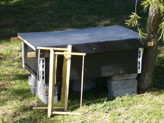
14 June 2006 - The set up
28 June 2006 - The swarm catching - CLICK HERE
1 August 2006 - 1st Rains but no colony ...yet - CLICK HERE
25 October 2006 - We have 2nd & 3rd rain and a Colony - CLICK HERE
Welcome To the JHH Logbook - June
The Jackson Horizontal hive is based on the top bar hive design however it has some unique modifications.
1st August
About 10 days ago, I took the entrance feeder and placed it inside of the JH hive box about 2/3rds back in order to attract scout bees. Below you see how I first placed the entrance feeder and it is generally used.
My idea has resulted in many bees entering and exiting the JH hive but not yet swarming and taking up residence. Although I had been successful with a similar plan last year this time round it does not seem to have worked on this attempt. Time is on my side...

No fuss. I then placed a number of full wax foundation sheets on to the frames and placed these near the halfway point of the box. I then placed the honey water solution we made on June 28th [CLICK HERE] behind the last waxed frame.
We watched and waited. Bees took a day to realise there was still something sweet about this box. Again frantic movement in and out of the entrance to the feeder. No swarm.
Unfortunately, while the experiment has been running I also inspected one of the hives BeeWare removed 2 months ago. The colony had absconded and left. Evident that the colony made an emergency queen which I will take a pic of and upload next log. Bees are still robbing the little honey the swarm left after it gorged itself for the trip. So you win some - you 'catch' others.
I was using a plywood Nuc catch box. The sides have warped slightly due to weather beating. I had nailed them back into place but I reckon this created unsatisfactory air conditioning with the recent cold. The bees probably struggled to keep the internal temperature constant. The plywood boxes, bought from a supplier, may be lacking in winter cold insulation. I will be using a polyurethane packaging foam next year to wrap around the box to insulate it.
I also noticed ants. If enough ants begin to pester a colony they may well leave. Be sure to raise the hive off of the ground and if possible, place an oil based 'guard' on the legs of a hive rest or table.
Back to the swarm catching. I will be changing the location of the JH hive this weekend. It may be too close to the other hives to warrant swarming. Bear in mind when we did this last year, I did not have any hives at the site. It may well require me to move the JH hive completely off site in order to enable a swarm to move in.
Once a swarm takes hold in the hive I can always move the box back to the apiary after checking for presence of Capensis.
With the first rains, I believe that it will prove easier now to catch swarms. Bees will start to get ready for the nectar flow. When the nectar flow is strong bees tend to swarm while the new colony has a good chance of settling down and still have sources of food.
Oh, BeeWare is launching a beekeeper's Club in Midrand. If you are interested look up the details here
My next plan is to move the JH hive roughly 20m away from its current position. Refill the feeder and wait. One can use honeybee queen pheromone chemicals and 'swarm catcher' pheromone which can be bought from some suppliers. I have the old queen cell from the colony that absconded. It may make an interesting side experiment to see what results may occur by using the empty frame containing the queen cell in a Nuc box.
Another factor to consider soon is that of increasing bee hive numbers. With the first rains nectar and pollen flows should follow soon. It is a good time to begin feeding your bee hives with the intent to split them near the end of August or beginning of September. Be mindful of cold fronts. Ensure both bee colonies have solutions after splitting as well.
I will have an update soon. If you can, join us at the first Midrand beekeepers club meeting.
This is the JHH site for the logbook experiment.
Be sure to check the next insert.
[Bee Gloves] [Bee suits] [Hive Tools] [Bee Hives] [Smokers] [Blue book]
[Wax foundation sheets] [Queen excluders] [Bee brushes] [Honey knife] [Extractors]
** Call to discuss your needs. Go to Contact Us!
|
